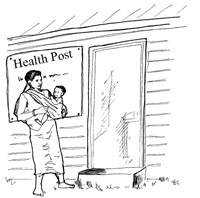1.3 The IMNCI assessment
When you are assessing a sick child, a combination of individual signs leads to one or more classifications, rather than to a diagnosis. IMNCI classifications are action-oriented illness categories which enable a healthcare provider to determine if a child should be urgently referred to a health centre, if the child can be treated at the health post (e.g. with oral antibiotic, antimalarial, ORS, etc.), or if the child can be safely managed at home.

The IMNCI guidelines describe how you should care for a child who is brought to your health post with an illness, or for a scheduled follow-up visit to check the child’s progress. The guidelines give instructions for how to routinely assess a child for general danger signs (or possible bacterial infection in a young infant), common illnesses, malnutrition and anaemia, and to look for other problems. In addition to treatment, the guidelines incorporate basic activities for illness prevention.
This module will help you learn to use the IMNCI guidelines in order to interview caregivers, accurately recognise clinical signs, choose appropriate treatments, and provide counselling and preventive care.
1.2.1 Objectives and advantages of IMNCI
